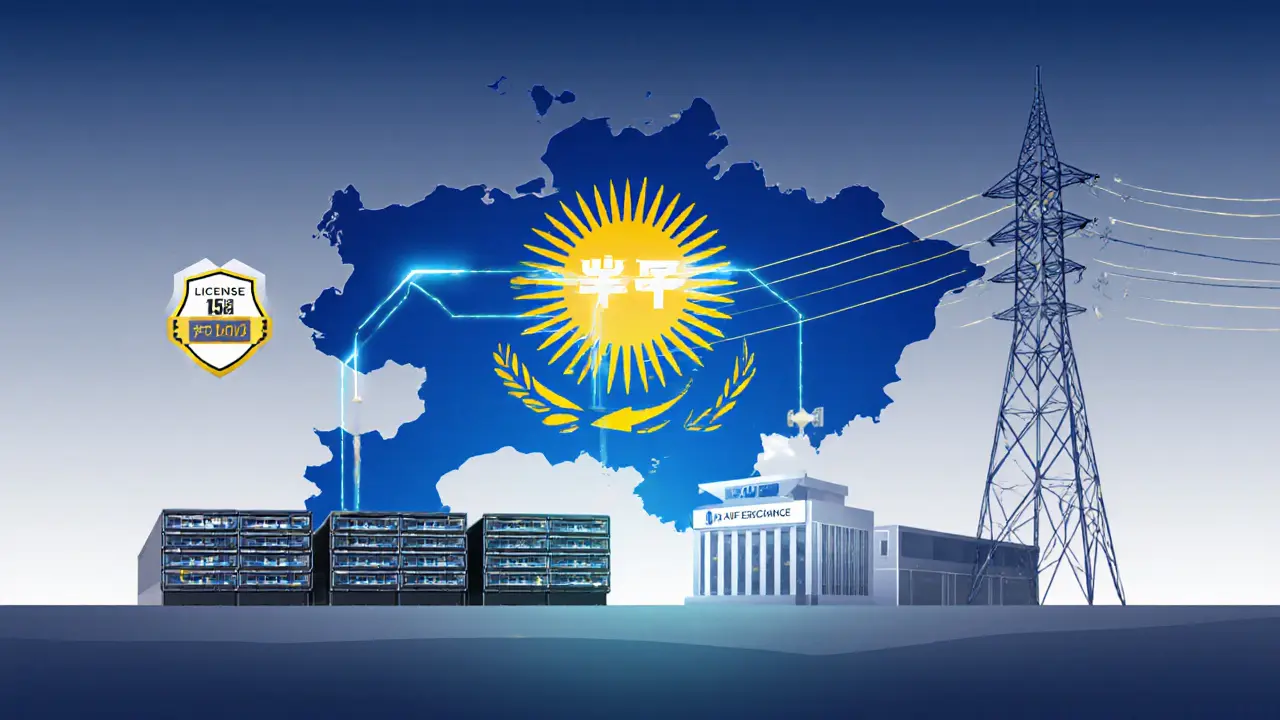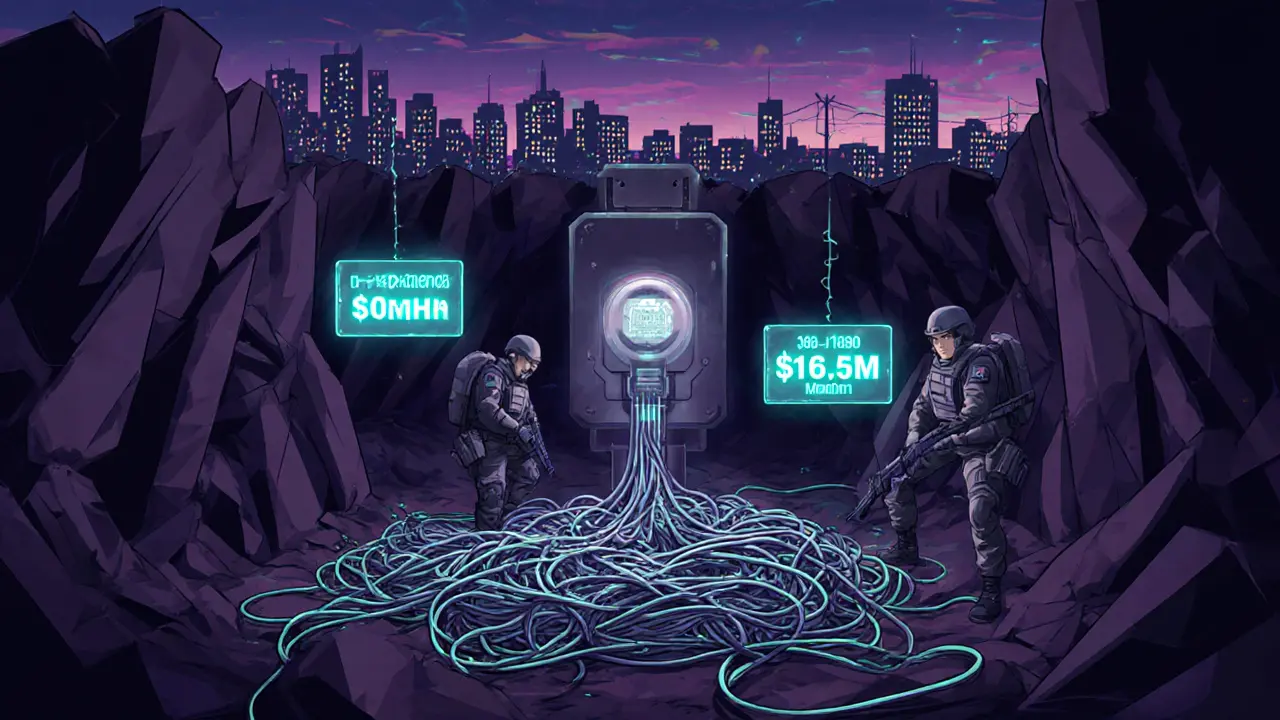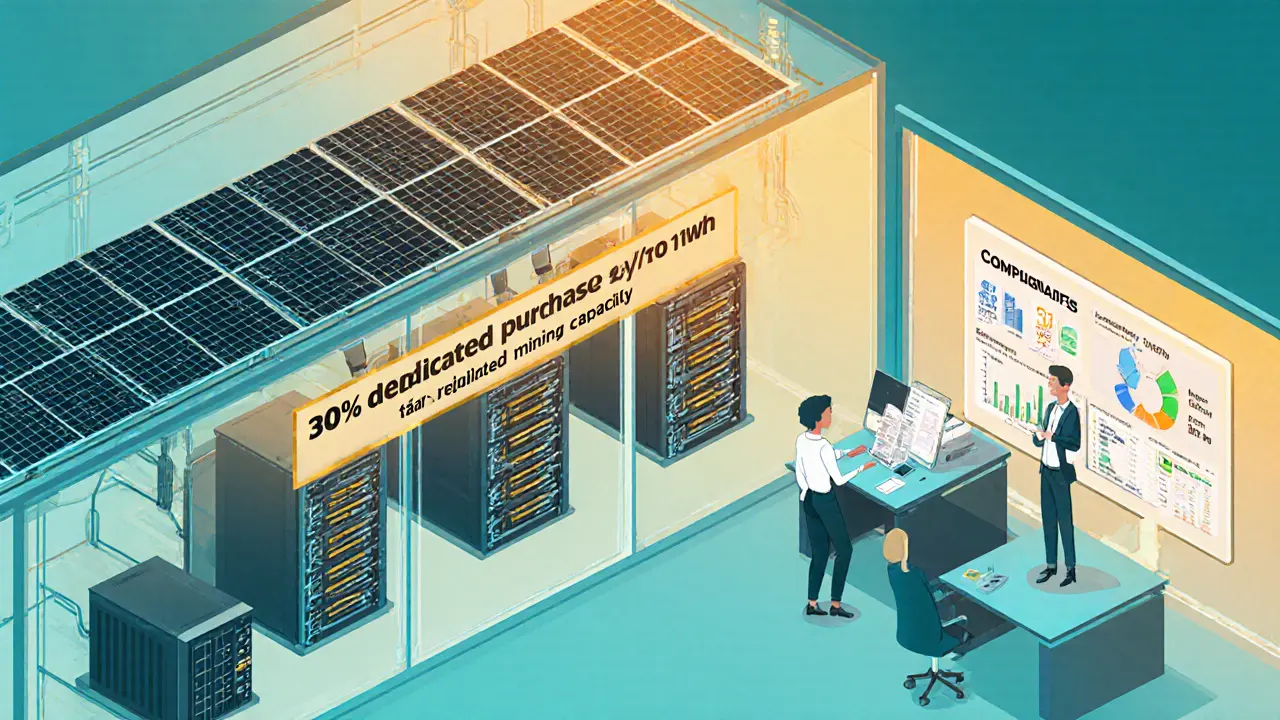May 28, 2025, Posted by: Ronan Caverly

Kazakhstan Crypto Mining Compliance Calculator
Your Compliance Overview
Quick Summary
- Kazakhstan introduced a state‑run electricity marketplace in 2022 to cap crypto miners at 1MWh per purchase.
- Legal miners must hold one of 84 licenses, register every machine, pay a 15% tax and sell 75% of mined coins on AIFC platforms.
- Illegal mining still robs the grid - a 2025 bust in East Kazakhstan stole over 50MWh, equal to a small city’s consumption.
- Compliance adds 10‑15% to operating costs, but the system protects residential power and attracts foreign investment via the 70/30 energy programme.
- Future policy tweaks will likely tighten monitoring while expanding legitimate capacity.
Electricity rationing for crypto mining in Kazakhstan is a government‑controlled scheme that limits how much power cryptocurrency miners can draw from the national grid, while forcing a large share of mined assets onto regulated exchanges.
Why Kazakhstan Became a Mining Magnet
When China outlawed crypto mining in 2021, thousands of operators fled east. Kazakhstan, with its cheap coal‑heavy electricity and open‑border policies, welcomed the exodus. The influx swelled the country’s hash‑rate overnight, turning it into the world’s third‑largest mining hub by 2023. At first, policymakers touted the economic windfall - job creation, tax revenue, and a modern tech image. But the sudden surge overloaded the Soviet‑era grid, leading to blackouts in Almaty and power‑rationing for factories.
How the Rationing System Works
Kazakhstan Ministry of Energy now runs a mandatory electricity marketplace. Every licensed miner can only buy up to 1MWh per transaction, forcing larger farms to split orders across multiple days. The platform is the sole legal source of power for mining; any direct deal with regional utilities is classified as illegal.
To obtain a license, a farm must:
- Submit an application to the Ministry of Energy and demonstrate technical capacity.
- Register every ASIC or GPU in the national database - 415,000 machines logged by 2023.
- Partner with one of five state‑approved mining pools.
- Agree to a 15% tax on net mining profits.
- Commit to selling at least 75% of mined coins on Astana International Financial Centre (AIFC) platforms, up from 50% in 2024.
The AIFC requirement creates a transparent channel for regulators to monitor capital flows and curb money‑laundering. Non‑compliant farms face fines, license revocation, and potential criminal charges.
Enforcement and the East Kazakhstan Bust
Despite tight rules, illegal mining flourished. In October 2025, the Kazakhstan Financial Monitoring Agency (AFM) teamed up with the National Security Committee (KNB) to raid an underground farm in East Kazakhstan Oblast. The operation had siphoned over 50MWh of electricity - roughly the demand of a city of 60,000 residents - for two years. The stolen power, worth about 9billion tenge (≈$16.5million), financed two apartments in Astana and four luxury cars, all later seized.
The case highlighted two systemic flaws:
- Corrupt utility insiders could sell residential quota electricity to miners unchecked.
- Monitoring tools struggled to differentiate legal from illegal consumption because both used the same grid infrastructure.
Since the bust, the Ministry has introduced real‑time metering alerts and tighter audit trails for regional distributors, but the risk of insider collusion remains.

Impact on Legitimate Miners
Legal operators report mixed experiences. The 1MWh cap forces them to schedule purchases, which can delay scaling during peak profitability periods. Administrative bottlenecks at the state marketplace also increase latency compared with direct utility contracts available elsewhere.
On the plus side, the licensing regime offers predictability: miners know the tax rate, can plan for the 75% asset‑sale rule, and benefit from government‑backed grid stability guarantees. Smaller farms, however, feel the compliance burden keenly; paperwork, quarterly reporting, and the need for specialized legal counsel can eat up 10‑15% of operating expenses.
Large, well‑capitalized firms have adapted by developing internal compliance teams and automating purchase orders to stay within the 1MWh limit. They also leverage the proposed 70/30 energy programme, which promises 30% of newly built thermal capacity dedicated to mining, reducing reliance on the capped marketplace.
Economic and Energy Implications
The rationing system aims to protect essential services - homes, hospitals, and strategic industries - from power shortages. By limiting the aggregate mining load, the grid avoids the blackouts that plagued the 2022‑2023 winter months. The 15% tax and forced asset sales generate state revenue estimated at $150million annually, which the government earmarks for grid upgrades.
Conversely, the system could stifle the sector’s growth potential. Analysts project Kazakhstan’s crypto mining market to reach $2.75billion in 2025, with a 13% CAGR through 2035. If the regulatory environment remains overly restrictive, foreign investors may divert capital to friendlier jurisdictions like Texas or the United Arab Emirates.
The Kazakhstan crypto mining regulation therefore walks a tightrope: it must keep the lights on for citizens while keeping miners profitable enough to stay.
Future Outlook and Policy Trends
Legislators are already discussing refinements. Deputy Ekaterina Smyshlyaeva proposes expanding the licensing framework to cover crypto exchanges, potentially de‑criminalising trading for users of vetted platforms. The ongoing East Kazakhstan investigation may trigger stricter utility oversight, including mandatory digital signatures for all electricity sales.
The 70/30 energy programme, still in draft form, could attract foreign capital to upgrade thermal plants. If 30% of the extra capacity is locked for mining, legitimate operators would gain a dedicated power source outside the 1MWh cap, easing compliance pains.
Short‑term, expect tighter real‑time monitoring, higher fines for illegal diversion, and a faster licensing pipeline to encourage compliance. Long‑term, Kazakhstan may position itself as the only country with a fully state‑regulated mining ecosystem, a unique selling point for investors seeking regulatory certainty.
Checklist: What You Need to Start Mining Legally in Kazakhstan (2025)
- Secure one of the 84 available mining licenses from the Ministry of Energy.
- Register every mining device in the national equipment database.
- Choose an accredited mining pool and sign a service agreement.
- Set up a corporate account on an AIFC‑approved exchange for asset sales.
- Implement an electricity tracking system capable of logging each 1MWh purchase.
- Budget for a 15% tax on net profits and 10‑15% of expenses for compliance staff.
- Prepare quarterly reports on power consumption and asset sales for submission to the Ministry.
Legal vs. Illegal Mining: Quick Comparison
| Aspect | Licensed Mining | Illegal Mining |
|---|---|---|
| Power source | State‑run marketplace, capped at 1MWh per purchase | Hijacked residential or industrial quotas via corrupt utility staff |
| Taxation | 15% on net profits, paid to Ministry of Energy | None (profits hidden, money laundering through assets) |
| Asset sale requirement | 75% of mined coins sold on AIFC platforms | Free market sales, often through unregulated exchanges |
| Legal risk | Fines for non‑compliance, but protected by license | Criminal charges, equipment seizure, up to 10years imprisonment |
| Operational cost overhead | 10‑15% of OPEX for compliance and reporting | Lower apparent costs, but risk of sudden shutdown |

Frequently Asked Questions
Do I need a license to mine any cryptocurrency in Kazakhstan?
Yes. Since the 2022 energy reform, any operation that consumes grid electricity for crypto mining must hold a Ministry of Energy license, regardless of the coin being mined.
What is the 1MWh transaction limit and how does it affect large farms?
The limit caps each purchase order at 1megawatt‑hour. Large farms must split their daily power needs among multiple orders, which can delay scaling during price spikes and adds administrative overhead.
Why must 75% of mined coins be sold on AIFC platforms?
The rule gives regulators real‑time visibility into crypto flows, helping prevent money laundering and ensuring that a majority of mining revenue stays within the formal financial system.
What penalties do illegal miners face if caught?
Authorities can impose hefty fines, confiscate equipment, and pursue criminal charges that carry up to ten years imprisonment, as demonstrated by the 2025 East Kazakhstan case.
Is the 70/30 energy programme already active?
It is still under legislative review. If approved, foreign investors will fund thermal upgrades, with 30% of the new capacity earmarked for licensed mining farms.
Write a comment
Comments
Rochelle Gamauf
The current regulatory framework in Kazakhstan appears to be a patchwork of ad‑hoc measures. It is evident that policymakers have not undertaken a comprehensive risk assessment. Consequently, miners are forced to navigate a labyrinth of intermittent power cuts. Such volatility undermines the economic viability of legitimate operations. In short, the situation calls for a strategic overhaul.
May 28, 2025 AT 06:45
Jerry Cassandro
When you look at the numbers, the electricity rationing has a cascading effect on hash rates across the region. Mining farms that once enjoyed near‑continuous power are now forced to schedule downtime, which directly translates to lower expected yields. The compliance calculator you linked is a useful first‑step, but it omits a few critical variables.
First, the opportunity cost of idle equipment during blackouts can be substantial, especially for ASICs that depreciate quickly.
Second, the price volatility of the underlying cryptocurrency amplifies the risk; a dip in market price can turn a marginally profitable operation into a loss.
Third, local labor regulations may require additional staffing to monitor power availability, increasing operational overhead.
Fourth, the environmental impact of running backup generators introduces both fiscal and reputational costs.
Fifth, the lag in governmental response to power shortages creates uncertainty that discourages new investment.
Sixth, the broader macro‑economic climate in Kazakhstan, including inflation and currency exchange rates, further complicates cash flow projections.
Seventh, the mining community’s reliance on cheap electricity as a competitive advantage means that any shift in policy can trigger a rapid exodus of hash power.
Eighth, the interplay between regional grid stability and mining demand can lead to localized blackouts that affect even non‑mining consumers.
Ninth, the potential for regulatory fines for exceeding allocated power quotas cannot be ignored.
Tenth, miners must also consider the opportunity to diversify into renewable energy sources, which may mitigate some of these risks.
Eleventh, the cost of upgrading equipment to be more energy‑efficient could be justified in the long run.
Twelfth, community sentiment on forums often skews negative during prolonged outages, affecting morale.
Thirteenth, the availability of technical support for troubleshooting power issues is limited in remote areas.
Fourteenth, insurance premiums for facilities in high‑risk zones are on the rise.
Fifteenth, and finally, the strategic decision to either downsize or relocate depends heavily on a realistic assessment of these cumulative factors.
In essence, the rationing policy forces miners to adopt a far more nuanced risk management approach than before.
June 4, 2025 AT 19:25
Parker DeWitt
Honestly, I think the whole panic about "rationing" is just hype. 😤 The grid can handle more than you think, and miners will just find loopholes. 🤔 Plus, if the government wants to keep the power, they should just tax us more and let us keep mining. 💡
June 12, 2025 AT 08:05
Allie Smith
i get why ppl are stressin, but ive seen worse. it’s like, we can still crank out blocks even when the lights flicker. just roll with the vibes and keep an eye on the meter.
June 19, 2025 AT 20:45
Lexie Ludens
Another day, another power cut, and here we are pretending it’s not a drama. The lights flicker, the fans whine, and I’m left staring at a blank screen. How theatrical.
June 27, 2025 AT 09:25
Aaron Casey
Building on Rochelle’s point, the intermittent supply introduces latency in the consensus algorithm, which can elevate orphan rates. From a network‑level perspective, this translates to a marginal increase in variance of block propagation time. Operators should therefore consider implementing dynamic load‑balancing clusters to mitigate hash‑rate volatility.
July 4, 2025 AT 22:05
Leah Whitney
Great breakdown, Jerry. I’d add that newcomers can use the calculator to model different fallback scenarios, like running on diesel generators for a few hours a day.
July 12, 2025 AT 10:45
Lisa Stark
The philosophical angle here is fascinating: power is both literal and metaphorical in the mining ecosystem. When the grid falters, it forces a reevaluation of what we truly value-efficiency or resilience?
July 19, 2025 AT 23:25
Logan Cates
Don’t forget that the government might be playing a hidden hand. Some say the outages are staged to drive up energy prices, which benefits a shadowy elite.
July 27, 2025 AT 12:05
Shelley Arenson
Sending positive vibes to everyone dealing with the blackouts! 🌟 Stay safe and keep those rigs humming when you can.
August 4, 2025 AT 00:45
Joel Poncz
Appreciate the optimism, Shelley. It’s a tough grind, but community support makes a difference.
August 11, 2025 AT 13:25
Kris Roberts
There’s an inherent tension between centralised power control and the decentralised ethos of crypto. Each outage reminds us that true decentralisation goes beyond just the blockchain.
August 19, 2025 AT 02:05
lalit g
I see this as an opportunity for dialogue between miners and regulators. Mutual understanding can lead to more stable policies.
August 26, 2025 AT 14:45
Reid Priddy
While dialogue sounds nice, historically those talks have been a façade. The real agenda is to control the hash‑rate and keep profits in the hands of a few.
September 3, 2025 AT 03:25
Shamalama Dee
For those navigating the compliance maze, remember that thorough documentation can protect you from unexpected fines. Treat the calculator as a baseline, not the final word.
September 10, 2025 AT 16:05
scott bell
Loved the advice! Just make sure you don’t over‑complicate things – keep it simple and stay focused
September 18, 2025 AT 04:45
vincent gaytano
Sure, let’s all trust the “official” numbers while ignoring the fact that the power grid is a circus. 🎪
September 25, 2025 AT 17:25
Dyeshanae Navarro
In plain terms, less power means less mining, and that’s a fact. The community just needs to adapt.
October 3, 2025 AT 06:05
Matt Potter
Keep your heads up, miners! Every challenge is a chance to innovate.
October 10, 2025 AT 18:45
Marli Ramos
Energy drama 😅
October 18, 2025 AT 07:25
Christina Lombardi-Somaschini
Esteemed members of the community, it is imperative to recognise that the ongoing electricity rationing in Kazakhstan constitutes a non‑trivial variable in the profitability models of cryptocurrency mining operations. Accordingly, one must adopt a methodical approach to risk mitigation, encompassing both operational and regulatory dimensions. A rigorous diligence process, inclusive of scenario analysis and contingency planning, will serve to safeguard investor capital against the vicissitudes of power availability.
October 25, 2025 AT 20:05
katie sears
Please consider integrating these risk‑assessment steps into your compliance framework.

Author
Ronan Caverly
I'm a blockchain analyst and market strategist bridging crypto and equities. I research protocols, decode tokenomics, and track exchange flows to spot risk and opportunity. I invest privately and advise fintech teams on go-to-market and compliance-aware growth. I also publish weekly insights to help retail and funds navigate digital asset cycles.